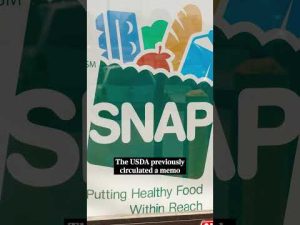**SNAP Benefits on Pause: Who’s to Blame?**
In a surprising twist during the ongoing government shutdown, the Department of Agriculture has announced that Supplemental Nutrition Assistance Program (SNAP) benefits will not be distributed on November 1st. This surprising decision is causing quite a stir among millions of Americans who rely on these food stamp benefits to put food on their tables. The USDA has pointed fingers squarely at Democrats, blaming their lack of support for a Republican-backed funding resolution for this funding shortfall. Talk about throwing shade!
According to the USDA, nearly 42 million Americans depend on SNAP to purchase food, averaging about $187.20 in benefits per month. That’s a significant chunk of change, especially for families trying to make ends meet. The USDA’s notice suggested that Senate Democrats have held out on passing necessary legislation, with only three Democratic senators breaking ranks to support the efforts of their Republican colleagues. The message was clear: Democrats should choose between supporting healthcare for illegal immigrants or ensuring that vulnerable families get the nutrition they need. It certainly looks like a classic Washington showdown!
While the drama unfolds, Democrats are pushing back, proposing their own funding measures. Their plan centers around extending subsidies for the Affordable Care Act, as they anticipate a rise in insurance premiums after the year ends. However, they are adamant that they are not attempting to provide healthcare benefits to those living in the country without legal status. It’s a classic game of political hot potato with both sides firing back at each other across the aisle.
As states grapple with the fallout, some have decided to take matters into their own hands by using their own funds to cover SNAP costs temporarily. But here comes the kicker: According to a memo from the USDA, these states won’t be reimbursed by the federal government once things get back to normal. This places a hefty financial burden on state funds and adds another layer of complexity to the already tangled web of government finances. States might find themselves stuck in a tight spot trying to feed their residents during this crisis.
To top it all off, the current situation sheds light on how vital these SNAP benefits are to American households. The program costs federal taxpayers roughly $99.8 billion a year, or about $8.3 billion each month. So, it’s not just a small line item in the budget—it’s a significant expenditure that directly impacts millions of lives. As the nation watches the drama unfold in Washington, one question remains: How long will it take for our lawmakers to come together and ensure that those in need receive the help they deserve? The clock is ticking!







